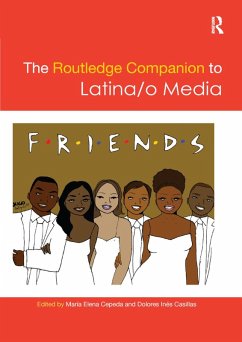The Routledge Companion to Latina/O Media
Herausgeber: Cepeda, Maria; Casillas, Dolores Inés
The Routledge Companion to Latina/O Media
Herausgeber: Cepeda, Maria; Casillas, Dolores Inés
- Broschiertes Buch
- Merkliste
- Auf die Merkliste
- Bewerten Bewerten
- Teilen
- Produkt teilen
- Produkterinnerung
- Produkterinnerung
The Routledge Companion to Latina/o Media provides students and scholars with an indispensable overview of the domestic and transnational dynamics at play within multi-lingual Latina/o media. The book examines both independent and mainstream media via race and gender in its theoretical and empirical engagement with questions of product
Andere Kunden interessierten sich auch für
![The Routledge Companion to Caste and Cinema in India The Routledge Companion to Caste and Cinema in India]() The Routledge Companion to Caste and Cinema in India61,99 €
The Routledge Companion to Caste and Cinema in India61,99 €![The Routledge Companion to Media Studies and Digital Humanities The Routledge Companion to Media Studies and Digital Humanities]() The Routledge Companion to Media Studies and Digital Humanities59,99 €
The Routledge Companion to Media Studies and Digital Humanities59,99 €![The Travels of Media and Cultural Products The Travels of Media and Cultural Products]() Enrique Uribe-JongbloedThe Travels of Media and Cultural Products29,99 €
Enrique Uribe-JongbloedThe Travels of Media and Cultural Products29,99 €![Arabic Media Coverage of Pandemics Arabic Media Coverage of Pandemics]() El Mustapha LahlaliArabic Media Coverage of Pandemics55,99 €
El Mustapha LahlaliArabic Media Coverage of Pandemics55,99 €![Racial Spectacles Racial Spectacles]() Jonathan MarkovitzRacial Spectacles63,99 €
Jonathan MarkovitzRacial Spectacles63,99 €![Reexamining Racism, Sexism, and Identity Taxation in the Academy Reexamining Racism, Sexism, and Identity Taxation in the Academy]() Reexamining Racism, Sexism, and Identity Taxation in the Academy55,99 €
Reexamining Racism, Sexism, and Identity Taxation in the Academy55,99 €![The Routledge Companion to Cinema and Politics The Routledge Companion to Cinema and Politics]() The Routledge Companion to Cinema and Politics48,99 €
The Routledge Companion to Cinema and Politics48,99 €-
-
-
The Routledge Companion to Latina/o Media provides students and scholars with an indispensable overview of the domestic and transnational dynamics at play within multi-lingual Latina/o media. The book examines both independent and mainstream media via race and gender in its theoretical and empirical engagement with questions of product
Produktdetails
- Produktdetails
- Verlag: Taylor & Francis
- Seitenzahl: 460
- Erscheinungstermin: 10. Dezember 2019
- Englisch
- Abmessung: 244mm x 173mm x 28mm
- Gewicht: 680g
- ISBN-13: 9780367868789
- ISBN-10: 0367868784
- Artikelnr.: 58483152
- Herstellerkennzeichnung
- Libri GmbH
- Europaallee 1
- 36244 Bad Hersfeld
- gpsr@libri.de
- Verlag: Taylor & Francis
- Seitenzahl: 460
- Erscheinungstermin: 10. Dezember 2019
- Englisch
- Abmessung: 244mm x 173mm x 28mm
- Gewicht: 680g
- ISBN-13: 9780367868789
- ISBN-10: 0367868784
- Artikelnr.: 58483152
- Herstellerkennzeichnung
- Libri GmbH
- Europaallee 1
- 36244 Bad Hersfeld
- gpsr@libri.de
María Elena Cepeda is Associate Professor of Latina/o Studies at Williams College, where her research and teaching focus on transnational Latina/o popular media and music, audience studies, gender, and language politics. She is the author of Musical ImagiNation: U.S.-Colombian Identity and the Latin Music Boom. Dolores Inés Casillas is Associate Professor in the Department of Chicana and Chicano Studies at the University of California, Santa Barbara. She has published essays on radio humor, "accent" use within popular culture, immigration-based media, Chicana/o listening practices and the award-winning book, Sounds of Belonging!: U.S. Spanish-Language Radio and Public Advocacy.
Part I: Understanding Contemporary Latina/o Media Introduction Chapter 1:
Authenticity, Appropriation, Articulation: The Cultural Logic of Latinidad,
Esteban del Río Chapter 2: The Transnational Restructuring of Communication
and Consumption Practices: Latinos in the Urban Settings of Global Cities,
Jéssica Retis Chapter 3: A Political-Economic Analysis of the Evolution of
Latino Media in the New Latino South, Lucila Vargas and Joseph Erba Chapter
4: Implicit Utopias and Ambiguous Ethnics:? Latinidad and the
Representational Promised Land,Angharad Valdivia Chapter 5: Phenotypicality
Bias on Television?: A Quantitative Content Analysis of Primetime TV, Dana
Mastro and Alexander Sink Chapter 6: Beyond the Market: Lessons Learned
from Latina/o Audiences, Kristin Moran Part II: Access, Policy and
Production in Latina/o Media Introduction Chapter 7: Altering the U.S.
Soundscape through Latina/o Community Radio, Mari Castañeda Chapter 8: The
State of Emergency Communications at a Time of Population and Linguistic
Shifts: A Case Study in Central Texas, Federico Subervi? Chapter 9: Direct
to DVD: A Case Study of Latina/o Genre and Audience, Orquidea Morales
Chapter 10: From the Bronze Screen to the Computer Screen: Latina/o Web
Series and Independent Production, Vittoria Rodríguez and Mary Beltrán
Chapter 11: Latina/Latino Community Journalism: A San Francisco Case Study,
Katynka Zazueta Martínez Chapter 12: The Cycle of Latina/o Community Media
Activism: Digital Storytelling in Springfield, MA, Rogelio Miñana Part III:
Representations of Latinas/os in the Media Introduction Chapter 13:
Imagining Postville: National Public Radio and the Discourse of Latina/o
Representation, Hannah Noel Chapter 14: What's in an Accent?: Gender and
Cultural Stereotypes in the Work of Sofía Vergara, Héctor Fernández
L'Hoeste Chapter 15: The Location of (U.S.) Latin Rock, Ignacio Corona
Chapter 16: Singing about Separation: Deportation, #Not1More, and La Santa
Cecilia's 'ICE: El Hielo,' Lorena Alvarado Chapter 17: The
Deterritorialized Political Economy of Narcocorridos in the USA, Hector
Amaya Chapter 18: What To Do with All this Beauty?: The Political Economy
of Latina Stardom in the 21st Century, Frances Negrón-Muntaner Chapter 19:
Sofía Vergara Made Me Do It: On Beauty, Costeñismo and Transnational
Colombian Identity, Isabel Cristina Contreras Porras Chapter 20: Sex,
Service and Scenery: Latina Sexualities in the Pages of Vogue, Aida Hurtado
Part IV: Engendering New Practices and Meanings Behind Latina/o Media
Consumption Introduction Chapter 21: Voices from the Borderlands: Young
Latina/os Discuss the Impact that Culture and Identity have on their Media
Consumption, Viviana Rojas and Juan Piñón Chapter 22: Latina/os' Facebook
Usage: An Interethnic and Intergenerational Exploration of their Engagement
with a Social Networking Site, Adolfo Mora and Viviana Rojas Chapt
Authenticity, Appropriation, Articulation: The Cultural Logic of Latinidad,
Esteban del Río Chapter 2: The Transnational Restructuring of Communication
and Consumption Practices: Latinos in the Urban Settings of Global Cities,
Jéssica Retis Chapter 3: A Political-Economic Analysis of the Evolution of
Latino Media in the New Latino South, Lucila Vargas and Joseph Erba Chapter
4: Implicit Utopias and Ambiguous Ethnics:? Latinidad and the
Representational Promised Land,Angharad Valdivia Chapter 5: Phenotypicality
Bias on Television?: A Quantitative Content Analysis of Primetime TV, Dana
Mastro and Alexander Sink Chapter 6: Beyond the Market: Lessons Learned
from Latina/o Audiences, Kristin Moran Part II: Access, Policy and
Production in Latina/o Media Introduction Chapter 7: Altering the U.S.
Soundscape through Latina/o Community Radio, Mari Castañeda Chapter 8: The
State of Emergency Communications at a Time of Population and Linguistic
Shifts: A Case Study in Central Texas, Federico Subervi? Chapter 9: Direct
to DVD: A Case Study of Latina/o Genre and Audience, Orquidea Morales
Chapter 10: From the Bronze Screen to the Computer Screen: Latina/o Web
Series and Independent Production, Vittoria Rodríguez and Mary Beltrán
Chapter 11: Latina/Latino Community Journalism: A San Francisco Case Study,
Katynka Zazueta Martínez Chapter 12: The Cycle of Latina/o Community Media
Activism: Digital Storytelling in Springfield, MA, Rogelio Miñana Part III:
Representations of Latinas/os in the Media Introduction Chapter 13:
Imagining Postville: National Public Radio and the Discourse of Latina/o
Representation, Hannah Noel Chapter 14: What's in an Accent?: Gender and
Cultural Stereotypes in the Work of Sofía Vergara, Héctor Fernández
L'Hoeste Chapter 15: The Location of (U.S.) Latin Rock, Ignacio Corona
Chapter 16: Singing about Separation: Deportation, #Not1More, and La Santa
Cecilia's 'ICE: El Hielo,' Lorena Alvarado Chapter 17: The
Deterritorialized Political Economy of Narcocorridos in the USA, Hector
Amaya Chapter 18: What To Do with All this Beauty?: The Political Economy
of Latina Stardom in the 21st Century, Frances Negrón-Muntaner Chapter 19:
Sofía Vergara Made Me Do It: On Beauty, Costeñismo and Transnational
Colombian Identity, Isabel Cristina Contreras Porras Chapter 20: Sex,
Service and Scenery: Latina Sexualities in the Pages of Vogue, Aida Hurtado
Part IV: Engendering New Practices and Meanings Behind Latina/o Media
Consumption Introduction Chapter 21: Voices from the Borderlands: Young
Latina/os Discuss the Impact that Culture and Identity have on their Media
Consumption, Viviana Rojas and Juan Piñón Chapter 22: Latina/os' Facebook
Usage: An Interethnic and Intergenerational Exploration of their Engagement
with a Social Networking Site, Adolfo Mora and Viviana Rojas Chapt
Part I: Understanding Contemporary Latina/o Media Introduction Chapter 1:
Authenticity, Appropriation, Articulation: The Cultural Logic of Latinidad,
Esteban del Río Chapter 2: The Transnational Restructuring of Communication
and Consumption Practices: Latinos in the Urban Settings of Global Cities,
Jéssica Retis Chapter 3: A Political-Economic Analysis of the Evolution of
Latino Media in the New Latino South, Lucila Vargas and Joseph Erba Chapter
4: Implicit Utopias and Ambiguous Ethnics:? Latinidad and the
Representational Promised Land,Angharad Valdivia Chapter 5: Phenotypicality
Bias on Television?: A Quantitative Content Analysis of Primetime TV, Dana
Mastro and Alexander Sink Chapter 6: Beyond the Market: Lessons Learned
from Latina/o Audiences, Kristin Moran Part II: Access, Policy and
Production in Latina/o Media Introduction Chapter 7: Altering the U.S.
Soundscape through Latina/o Community Radio, Mari Castañeda Chapter 8: The
State of Emergency Communications at a Time of Population and Linguistic
Shifts: A Case Study in Central Texas, Federico Subervi? Chapter 9: Direct
to DVD: A Case Study of Latina/o Genre and Audience, Orquidea Morales
Chapter 10: From the Bronze Screen to the Computer Screen: Latina/o Web
Series and Independent Production, Vittoria Rodríguez and Mary Beltrán
Chapter 11: Latina/Latino Community Journalism: A San Francisco Case Study,
Katynka Zazueta Martínez Chapter 12: The Cycle of Latina/o Community Media
Activism: Digital Storytelling in Springfield, MA, Rogelio Miñana Part III:
Representations of Latinas/os in the Media Introduction Chapter 13:
Imagining Postville: National Public Radio and the Discourse of Latina/o
Representation, Hannah Noel Chapter 14: What's in an Accent?: Gender and
Cultural Stereotypes in the Work of Sofía Vergara, Héctor Fernández
L'Hoeste Chapter 15: The Location of (U.S.) Latin Rock, Ignacio Corona
Chapter 16: Singing about Separation: Deportation, #Not1More, and La Santa
Cecilia's 'ICE: El Hielo,' Lorena Alvarado Chapter 17: The
Deterritorialized Political Economy of Narcocorridos in the USA, Hector
Amaya Chapter 18: What To Do with All this Beauty?: The Political Economy
of Latina Stardom in the 21st Century, Frances Negrón-Muntaner Chapter 19:
Sofía Vergara Made Me Do It: On Beauty, Costeñismo and Transnational
Colombian Identity, Isabel Cristina Contreras Porras Chapter 20: Sex,
Service and Scenery: Latina Sexualities in the Pages of Vogue, Aida Hurtado
Part IV: Engendering New Practices and Meanings Behind Latina/o Media
Consumption Introduction Chapter 21: Voices from the Borderlands: Young
Latina/os Discuss the Impact that Culture and Identity have on their Media
Consumption, Viviana Rojas and Juan Piñón Chapter 22: Latina/os' Facebook
Usage: An Interethnic and Intergenerational Exploration of their Engagement
with a Social Networking Site, Adolfo Mora and Viviana Rojas Chapt
Authenticity, Appropriation, Articulation: The Cultural Logic of Latinidad,
Esteban del Río Chapter 2: The Transnational Restructuring of Communication
and Consumption Practices: Latinos in the Urban Settings of Global Cities,
Jéssica Retis Chapter 3: A Political-Economic Analysis of the Evolution of
Latino Media in the New Latino South, Lucila Vargas and Joseph Erba Chapter
4: Implicit Utopias and Ambiguous Ethnics:? Latinidad and the
Representational Promised Land,Angharad Valdivia Chapter 5: Phenotypicality
Bias on Television?: A Quantitative Content Analysis of Primetime TV, Dana
Mastro and Alexander Sink Chapter 6: Beyond the Market: Lessons Learned
from Latina/o Audiences, Kristin Moran Part II: Access, Policy and
Production in Latina/o Media Introduction Chapter 7: Altering the U.S.
Soundscape through Latina/o Community Radio, Mari Castañeda Chapter 8: The
State of Emergency Communications at a Time of Population and Linguistic
Shifts: A Case Study in Central Texas, Federico Subervi? Chapter 9: Direct
to DVD: A Case Study of Latina/o Genre and Audience, Orquidea Morales
Chapter 10: From the Bronze Screen to the Computer Screen: Latina/o Web
Series and Independent Production, Vittoria Rodríguez and Mary Beltrán
Chapter 11: Latina/Latino Community Journalism: A San Francisco Case Study,
Katynka Zazueta Martínez Chapter 12: The Cycle of Latina/o Community Media
Activism: Digital Storytelling in Springfield, MA, Rogelio Miñana Part III:
Representations of Latinas/os in the Media Introduction Chapter 13:
Imagining Postville: National Public Radio and the Discourse of Latina/o
Representation, Hannah Noel Chapter 14: What's in an Accent?: Gender and
Cultural Stereotypes in the Work of Sofía Vergara, Héctor Fernández
L'Hoeste Chapter 15: The Location of (U.S.) Latin Rock, Ignacio Corona
Chapter 16: Singing about Separation: Deportation, #Not1More, and La Santa
Cecilia's 'ICE: El Hielo,' Lorena Alvarado Chapter 17: The
Deterritorialized Political Economy of Narcocorridos in the USA, Hector
Amaya Chapter 18: What To Do with All this Beauty?: The Political Economy
of Latina Stardom in the 21st Century, Frances Negrón-Muntaner Chapter 19:
Sofía Vergara Made Me Do It: On Beauty, Costeñismo and Transnational
Colombian Identity, Isabel Cristina Contreras Porras Chapter 20: Sex,
Service and Scenery: Latina Sexualities in the Pages of Vogue, Aida Hurtado
Part IV: Engendering New Practices and Meanings Behind Latina/o Media
Consumption Introduction Chapter 21: Voices from the Borderlands: Young
Latina/os Discuss the Impact that Culture and Identity have on their Media
Consumption, Viviana Rojas and Juan Piñón Chapter 22: Latina/os' Facebook
Usage: An Interethnic and Intergenerational Exploration of their Engagement
with a Social Networking Site, Adolfo Mora and Viviana Rojas Chapt








